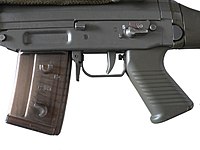
Photo from wikipedia
Abstract The corticospinal tract contributes to the control of finger muscles during precision and power grip. The involvement of different sets of cortical interneuronal circuits during these distinct grasping behaviors… Click to show full abstract
Abstract The corticospinal tract contributes to the control of finger muscles during precision and power grip. The involvement of different sets of cortical interneuronal circuits during these distinct grasping behaviors remains unknown. To examine this question in humans we used noninvasive transcranial magnetic stimulation (TMS) over the hand representation of the primary motor cortex to elicit motor evoked potentials (MEPs) in an intrinsic finger muscle during index finger abduction (control task), precision grip, and power grip. The TMS coil was oriented to induce currents in the brain in the latero‐medial (LM), posterior‐anterior (PA), and anterior‐posterior (AP) direction to preferentially activate corticospinal axons directly and early and late synaptic inputs to corticospinal neurons, respectively. We found that AP‐LM MEP latency differences were consistently longer during power grip compared with index finger abduction and precision grip, while PA‐LM differences remained similar across tasks. Short‐interval intracortical facilitation, targeting AP but not PA inputs, increased during power grip compared with other tasks. Our novel findings suggest that cortical structures activated by PA and AP stimuli are differentially active during precision and power grip. We propose that a preferential recruitment of late synaptic inputs to corticospinal neurons may be achieved when humans perform a power grip.
Journal Title: Cerebral Cortex
Year Published: 2017
Link to full text (if available)
Share on Social Media: Sign Up to like & get
recommendations!